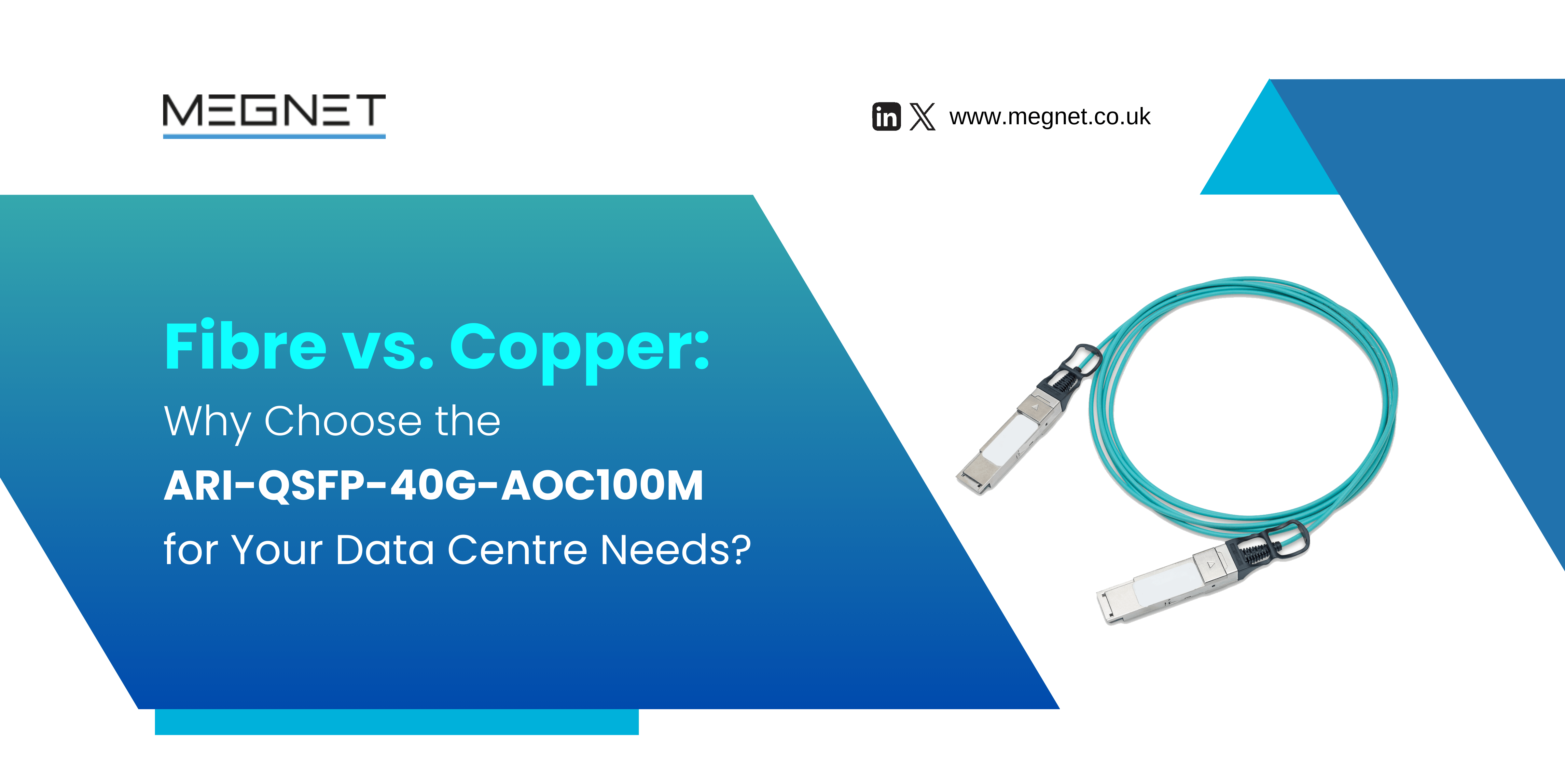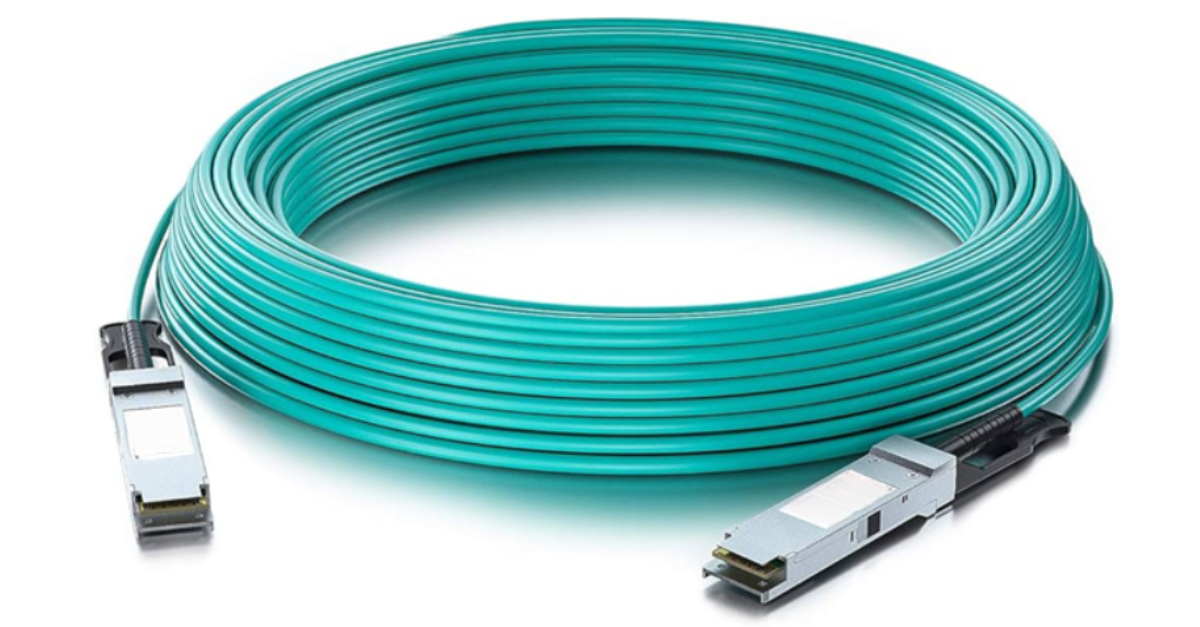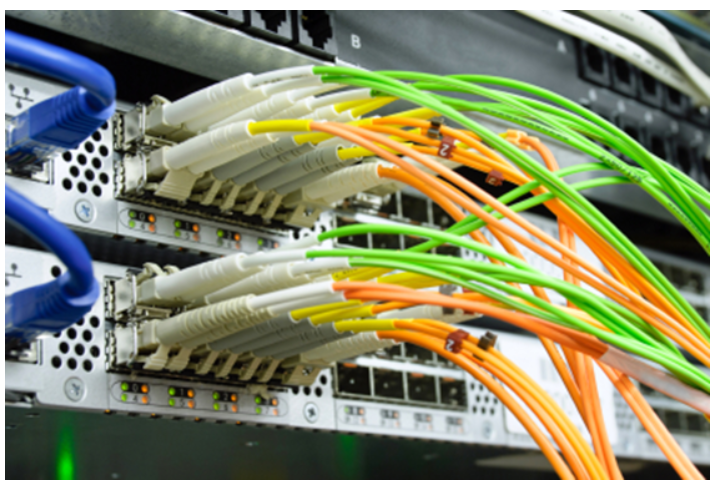
Why Choose the ARI-QSFP-40G-AOC100M for Your Data Centre Needs?
Data centres are bursting at the seams with ever-increasing data traffic. Traditional copper cabling struggles to keep pace, limited by distance, crosstalk, and bandwidth. This creates bottlenecks and unreliable connections.
Fibre optic cables offer a clear advantage, boasting superior speed, reach, and signal integrity. The ARI-QSFP-40G-AOC100M is a prime example – a 40 Gigabit Ethernet Active Optical Cable solution built for modern data centres.
This blog post dives into the limitations of copper and unveils the power of the 100 Meter QSFP+ AOC. We will explore its technical specifications, the benefits it offers, and its ideal applications within your data centre. Get ready to discover a future-proof cabling solution for your High-Speed Data Center Cable needs.
The Challenge: Data Growth and Cabling Limitations
Data centres are the beating hearts of our digital world, storing and processing the ever-increasing volume of information that fuels our daily lives. From social media interactions to complex scientific simulations, the amount of data flowing through these facilities is experiencing explosive growth. Cloud computing, virtualization, and the proliferation of bandwidth-intensive applications like artificial intelligence and machine learning are all contributing factors.
This surge in data traffic demands high-performance connectivity solutions within data centres. However, traditional copper cabling, while a mainstay for decades, is struggling to keep pace. Here is a closer look at the limitations of copper that hinder its effectiveness in modern data centres:
Crosstalk: Electrical signals travelling through adjacent copper cables can interfere with each other. This phenomenon, known as crosstalk, can corrupt data packets, leading to errors and unreliable network performance. In high-speed data centre environments with densely packed cables, crosstalk becomes a significant issue.
Signal Degradation: As data signals travel through copper cables, they weaken over distance. This signal degradation limits the effective reach of copper cabling. Beyond a certain distance, the signal becomes too weak to be reliably transmitted, requiring additional hardware like signal boosters or limiting the placement of devices within the data centre.
Limited Bandwidth: Copper cables are inherently limited in their ability to handle high bandwidths. Traditional copper cabling typically maxes out at speeds of 10 Gigabit Ethernet (GbE), which is simply insufficient for supporting the ever-increasing demands of modern data centre applications. As innovative technologies emerge and data processing requirements become more complex, 10GbE quickly becomes a bottleneck, hindering overall performance and scalability.
These limitations of copper cabling translate to several challenges for data centre operators:
- Unreliable Data Transmission: Crosstalk and signal degradation can lead to data errors and transmission inconsistencies, impacting application performance and user experience.
- Network Bottlenecks: Limited bandwidth capabilities of copper can create bottlenecks, hindering data flow and slowing down critical operations within the data centre.
- Frequent Hardware Upgrades: As data centre needs evolve and higher bandwidths become necessary, copper cabling may require frequent replacement, leading to additional costs and downtime associated with hardware upgrades.
- Restricted Placement of Devices: The limited reach of copper cables can restrict the placement of devices within the data centre, impacting layout flexibility and potentially requiring additional infrastructure to overcome reach limitations.
Fibre vs. Copper: A Clear Winner Emerges
The limitations of copper cabling become increasingly apparent as data centre needs push the boundaries of speed, reach, and reliability. Here’s a deeper dive into the head-to-head comparison between fibre optic and copper cables, highlighting the clear advantages of fibre for modern data centres:
- Speed and Bandwidth: Copper cables typically max out at 10 Gigabit Ethernet (GbE), which is simply insufficient for bandwidth-hungry applications like cloud computing, virtualization, and high-performance computing (HPC). Fibre optic cables, on the other hand, offer significantly higher bandwidth capabilities. Depending on the specific fibre type and configuration, they can support speeds ranging from 40GbE to 400GbE and beyond, effortlessly handling the demands of modern data centre traffic.
- Reach: Distances within data centres can be substantial, and copper cables struggle to maintain signal integrity over longer stretches. Signal strength weakens with increasing distance in copper, leading to data errors and the need for additional equipment like boosters or repeaters. Fibre optic cables boast exceptional reach capabilities. They can transmit data over hundreds of metres, even kilometres, without any significant signal degradation. This eliminates the need for repeaters and simplifies data centre infrastructure, especially in large facilities.
- Signal Integrity: Electrical signals in copper cables are susceptible to electromagnetic interference (EMI) from nearby power sources or other electronic equipment. This interference can corrupt data packets, leading to network errors and disruptions. Fibre optic cables transmit data using light pulses, which are completely immune to EMI. This ensures clean, error-free data transmission, even in environments with elevated levels of electrical noise.
- Power Consumption: Copper cables require more power to transmit data over longer distances. This not only increases your energy bills but also contributes to heat generation within the data centre, requiring additional cooling measures. Fibre optic cables, due to their lower signal degradation, transmit data efficiently with minimal power consumption. This translates to lower operating costs and a more environmentally friendly data centre operation.
- Weight and Flexibility: Copper cables are heavier and less flexible compared to fibre optic cables. This can make them more challenging to install, especially in tight spaces or when routing cables around obstacles. The lightweight and flexible nature of fibre optic cables allows for easier installation and improved cable management within the data centre.
While the initial cost of fibre optic cabling may be slightly higher than copper, the long-term benefits outweigh the upfront investment. The superior performance, reliability, and lower operating costs of fibre optic cables contribute to a significantly lower total cost of ownership (TCO) over the lifespan of the data centre infrastructure.
Introducing the ARI-QSFP-40G-AOC100M: A Powerful Solution for Your Data Centre

The ARI-QSFP-40G-AOC100M is more than just a high-performance 40 Gigabit Ethernet (GbE) 40G QSFP+ Active Optical Cable (AOC); it is a strategic investment in the future of your data centre. Here’s a deeper dive into its technical specifications and how it addresses critical data centre needs:
Unmatched Speed and Bandwidth
Supporting 40GbE, the ARI-QSFP-40G-Active Optic Cable 100M unlocks a new level of data transfer capability within your data centre. This translates to faster application performance, improved responsiveness for users, and a smoother overall data flow. With the ever-increasing demands of cloud computing, virtualization, and bandwidth-intensive applications, the 40GbE support ensures your network is prepared to handle these workloads without bottlenecks.
Long Reach Connectivity
Forget the limitations of copper cabling. The ARI-QSFP-40G-Active Optical Cable 100M boasts a remarkable reach of 100 metres (328 feet). This allows you to connect devices across larger distances within your data centre with ease. Imagine a scenario where your servers are spread out across a large room. Traditional copper cables might not reach the necessary distance without experiencing significant signal degradation. The ARI-QSFP-40G-AOC100M eliminates this limitation, providing a reliable and high-performance connection regardless of the physical layout of your data centre. This flexibility also simplifies future data centre expansions, as you won’t be restricted by cabling limitations when adding new equipment.
Designed for Efficiency
The ARI-QSFP-40G-Active Optical Cable 100M prioritises efficiency in several ways. Firstly, its low power consumption translates to lower energy bills and a reduced environmental footprint for your data centre. This is particularly important as data centres are notorious for their energy consumption. Secondly, the cable utilises OM3 Multimode Fiber AOC, a cost-effective option for intra-data centre applications. While single-mode fibre offers even longer reach, OM3 multimode fibre strikes a perfect balance between performance and cost for most data centre needs.
Built for Reliability
Data integrity is paramount in any data centre environment. The ARI-QSFP-40G-Active Optical Cable 100M ensures reliable signal transmission through its immunity to electromagnetic interference (EMI). This means your data is less susceptible to errors or corruption caused by external electromagnetic noise, a significant concern in data centres with a multitude of electronic devices. Additionally, the cable adheres to relevant industry standards for performance and reliability, guaranteeing consistent and dependable operation.
Simplified Management
The ARI-QSFP-40G-AOC100M is designed with user-friendliness in mind. It’s hot-swappable functionality allows for easy cable replacement during maintenance or upgrades without shutting down your entire network. This minimises downtime and simplifies maintenance procedures. The QSFP+ pluggable interface ensures seamless integration with existing network equipment, eliminating the need for complex configuration or additional adapters.
In summary, the ARI-QSFP-40G-Active Optical Cable 100M offers a compelling combination of speed, reach, efficiency, reliability, and user-friendliness. It’s a future-proof solution that can address the evolving needs of modern data centres, paving the way for a high-performance and reliable network infrastructure.
Benefits of Fibre Optics with the ARI-QSFP-40G-AOC100M
The ARI-QSFP-40G-AOC100M offers a multitude of benefits for your data centre:
- Unmatched Speed and Performance: Supports 40GbE for smooth data transmission and future-proofs your network for bandwidth-intensive applications.
- Long Reach Connectivity: Connects devices across distances of up to 100 metres, eliminating limitations imposed by copper cables.
- Reduced Power Consumption: Lowers your energy bills and contributes to a greener data centre environment.
- Reliable Signal Transmission: Immunity to electromagnetic interference (EMI) ensures clean and error-free data transfer.
- Simplified Installation and Maintenance: Hot-swappable design allows for easy cable replacement during maintenance or upgrades.
- Scalability and Future-Proofing: Supports 40GbE, enabling seamless network upgrades without requiring cable changes in the future.
- Cost-Effectiveness: While the initial cost may be higher than copper, the long lifespan, Low-Power Consumption AOC, and reduced maintenance needs contribute to a lower total cost of ownership (TCO).
Applications for the ARI-QSFP-40G-AOC100M

The ARI-QSFP-40G-AOC100M transcends basic 40 Gigabit Ethernet AOC network connectivity within a data centre. Its versatility extends to a wider range of applications that demand high-bandwidth, reliable data transfer:
- High-Performance Computing (HPC): In HPC clusters, where massive datasets are processed and analysed, speed and low latency are paramount. The ARI-QSFP-40G-Active Optical Cable 100M seamlessly connects compute nodes within the cluster, enabling rapid data exchange and accelerating complex calculations. This translates to faster time-to-results for simulations, modelling, and other computationally intensive tasks.
- Storage Area Networks (SANs): Modern SANs require high-bandwidth connections to ensure smooth data flow between servers and storage devices. The ARI-QSFP-40G-AOC100M bridges the gap between servers and Fibre Channel storage arrays, facilitating efficient access to critical data for applications like virtualization, database management, and large-scale file storage.
- Network Convergence: The trend towards network convergence involves consolidating multiple network types (voice, data, video) onto a single infrastructure. The ARI-QSFP-40G-Active Optical Cable 100M supports this approach by providing the bandwidth necessary to handle the combined traffic volume while maintaining application performance. This simplifies network management and reduces overall infrastructure complexity.
- Cloud Data Centers: Cloud service providers require robust connections between servers and storage systems to deliver seamless service to their clients. The ARI-QSFP-40G-Active Optical Cable 100M 100-metre reach is ideal for large cloud data centres, enabling efficient data transfer across vast server racks and storage arrays. Additionally, its low power consumption contributes to a greener cloud infrastructure.
- Emerging Applications: The ever-growing demand for bandwidth extends beyond traditional data centre applications. The ARI-QSFP-40G-Active Optical Cable 100M can support emerging technologies like artificial intelligence (AI) and machine learning (ML) that rely on massive datasets and real-time processing. Its reliable connectivity ensures smooth data flow within these applications, accelerating innovation and unlocking new possibilities.
Conclusion
In conclusion, copper cabling struggles to keep pace with the relentless growth of data centres. The ARI-QSFP-40G-Active Optical Cable 100M, a fibre optic solution, offers unmatched speed, reach, and reliability for your data centre needs. Reduced power consumption and lower TCO make it a future-proof investment.
Ready to unlock the power of fibre optics? At Megnet, we offer the finest AOC solutions, including the ARI-QSFP-40G-Active Optical Cable 100M. Visit our website or contact us today to explore our comprehensive selection and find the perfect fit for your data centre. Let Megnet be your partner in building a high-performance, reliable, and scalable network for the future.
FAQ's
Fibre optic cables like the ARI-QSFP-40G-AOC100M offer superior speed, reach, and reliability compared to copper cables, which are limited in bandwidth and susceptible to signal degradation.
While the initial cost might be higher, the lower power consumption, longer lifespan, and reduced maintenance needs of the ARI-QSFP-40G-Active Optical Cable 100M contribute to a lower TCO in the long run.
Yes, with a reach of 100 metres, it's ideal for connecting devices across larger distances within a data centre.
The cable utilises the QSFP+ pluggable interface, ensuring compatibility with most modern network switches and routers. For Arista Compatible QSFP+ AOC, check specific product details.
Absolutely. Its 40GbE support allows for smooth data transfer for bandwidth-intensive tasks.
Yes, its lower power consumption translates to reduced energy bills and an eco-friendlier data centre operation.
Yes, the hot-swappable design allows for easy cable replacement during maintenance or upgrades. No additional tools are typically required.
Fibre optic cables require minimal maintenance compared to copper. Regular visual inspections to ensure no physical damage are recommended.
Fibre optic cables are thinner and lighter than copper cables, making them easier to manage and route within data centre racks.
The 40GbE support ensures compatibility with current and near-future network requirements. However, for deployments anticipating a transition to 400GbE or beyond, consult with the vendor about future-proof solutions.








Leave a comment
Your email address will not be published. Required fields are marked *